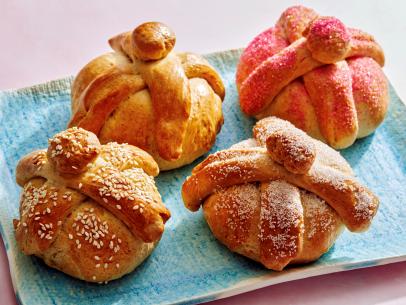
Recipe courtesy of Esteban Castillo
Recipe courtesy of Esteban Castillo
Watch how to make this recipe.
Pan de Muerto
Getting reviews...
- Level: Intermediate
- Total: 4 hr 15 min (includes rising, resting and cooling times)
- Active: 45 min
- Yield: 6 rolls
-
- Nutritional Analysis
- Per Serving
- Serving Size
- 1 of 6 servings
- Calories
- 769
- Total Fat
- 29 g
- Saturated Fat
- 17 g
- Carbohydrates
- 116 g
- Dietary Fiber
- 4 g
- Sugar
- 50 g
- Protein
- 13 g
- Cholesterol
- 132 mg
- Sodium
- 233 mg
Pan de muerto is typically enjoyed during the days leading up to Día de Muertos, which is observed November 1 through November 2. These sweet little rolls laced with aromatics like orange zest, cinnamon, cardamom, and ginger are used to represent those who have passed on. The rolls are topped with crossbones and a round ball to represent the skull, and sometimes they’re covered with sesame seeds to represent the tears of the deceased souls who haven’t been able to find peace. My recipe yields an incredibly soft spiced roll dusted with cinnamon sugar!
- Level: Intermediate
- Total: 4 hr 15 min (includes rising, resting and cooling times)
- Active: 45 min
- Yield: 6 rolls
-
- Nutritional Analysis
- Per Serving
- Serving Size
- 1 of 6 servings
- Calories
- 769
- Total Fat
- 29 g
- Saturated Fat
- 17 g
- Carbohydrates
- 116 g
- Dietary Fiber
- 4 g
- Sugar
- 50 g
- Protein
- 13 g
- Cholesterol
- 132 mg
- Sodium
- 233 mg
Ingredients
For the Rolls
For the Egg Wash
For Finishing
Directions
- In the microwave, heat the milk to 100 to 110 degrees F (38 to 43 degrees C), 35 to 40 seconds. Mix in the yeast and the 1 tablespoon sugar. Set the yeast aside for 10 minutes until bubbling.
- Meanwhile, in the bowl of a stand mixer, whisk together the flour, remaining 1/3 cup (67 g) sugar, cinnamon, ginger, nutmeg, cardamom, salt, and allspice. Grate the zest of the orange into the stand mixer bowl, then juice the orange into a measuring cup to measure out 1/4 cup (59 g) of orange juice. If the orange doesn’t have enough juice, simply add a bit of water until it meets 1/4 cup.
- Fit the stand mixer with the dough hook. Pour the yeast mixture into the bowl, turn the speed to low, and pour in the orange juice. Add the eggs, one at a time, beating well after each addition. Add the softened butter and let knead until the dough starts to come together into a ball, about 2 minutes, then gradually bump the speed up to medium and let knead for a final 4 minutes. Cover the bowl with plastic and let the dough rest in a dark and warm place until doubled in size, about 2 hours.
- Line two 13 x 18-inch (33 x 45 cm) half-sheet pans with parchment paper.
- Punch the dough down and let it rest for 5 minutes. Divide the dough into 8 equal portions (about 115 g each), and form into balls. Evenly space 6 of the balls on one baking sheet, then use your palm to flatten them.
- To form the crossbones, take the remaining 2 portions of dough and divide each one into 3 portions (about 39 g each), for a total of 6 small portions. You’ll be using each portion to form the crossbones.
- For each skull and crossbone set, use one of the small dough portions. Pull off 5 grams of the dough and roll it into a smooth ball (the “skull”) and place it on the empty lined sheet pan. Divide the remaining 34 grams of dough in two and roll each piece into a 6-inch (15 cm) snake with your hands. Lay a snake on the work surface, spread open your fingers, and roll with your fingertips so that some parts of the snake are lower than the others, to create a bone shape. Repeat this process with the remaining dough until you have six small balls and a set of crossbones for each roll. Place the skull and crossbone sets on the second baking sheet, lightly spritz two large pieces of plastic wrap with nonstick cooking spray, then loosely cover each baking sheet and place both baking sheets in a dark warm place to rise for 45 minutes.
- Meanwhile, preheat the oven to 350 degrees F (180 degrees C).
- Brush the risen rolls with the egg wash, then gently take the crossbones and crisscross them on top of each roll, gently brushing each piece with egg wash to hold them all together. Then place the little ball that represents the skull on top of the crossbones, making sure it’s in the center of the crisscrossed bones.
- Bake until lightly golden brown, 16 to 18 minutes.
- Meanwhile, in a small bowl, stir together the sugar and cinnamon.
- Transfer the baked rolls to a wire rack to cool for 10 minutes. Brush each roll with melted butter, sprinkle with cinnamon sugar, and tap off any excess. Serve the rolls warm.
Looking for Something Else?
Related Pages
- Instant Rice Pudding with Cinnamon, Cardamom and...
- Apple Cake with Maple, Orange Zest and Pistachios...
- Cranberry-Orange Sauce Recipe
- Candied Orange Zest Recipe
- Blueberries with Orange Zest Shortcake Recipe
- Japanese Rice with Black Olives and Orange Zest...
- Pacific Halibut with Caramelized Fennel, Black...
- Whole Seabass with Fennel and Orange Zest Recipe
- Buñuelos de Viento Recipe































